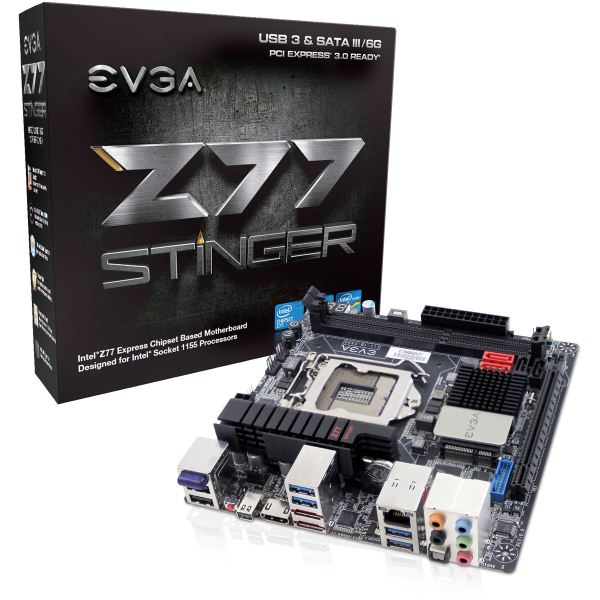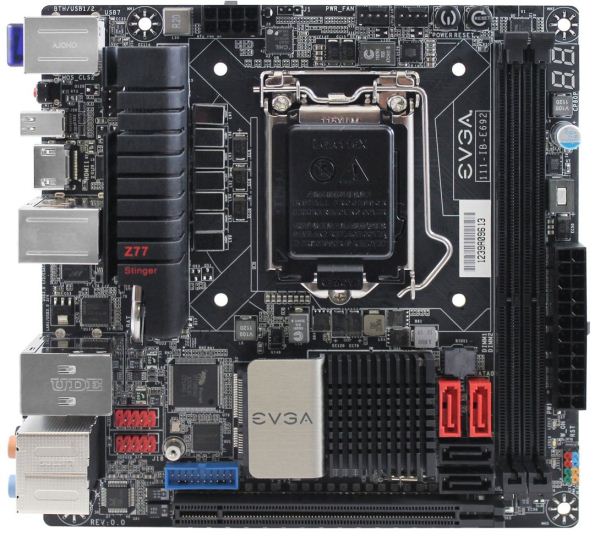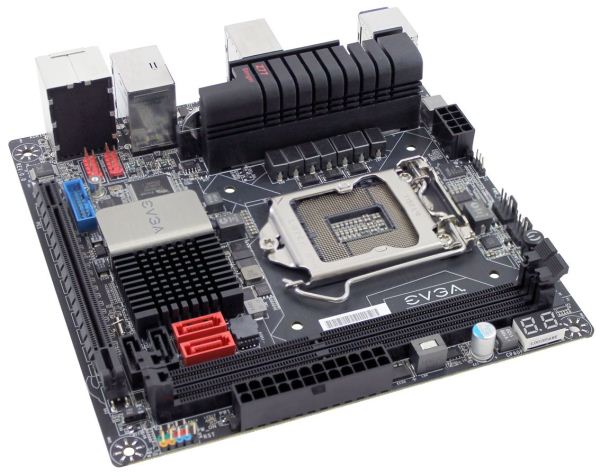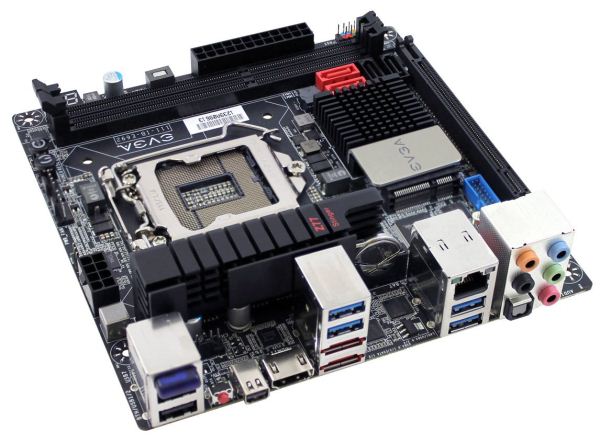Z77 mITX Round-Up: Five of the Best – MSI, Zotac, ASRock, EVGA and ASUS
by Ian Cutress on December 31, 2012 7:00 AM EST- Posted in
- Motherboards
- MSI
- ASRock
- EVGA
- ZOTAC
- Asus
- Ivy Bridge
- Z77
- mITX
EVGA Z77 Stinger Overview
For the fourth motherboard of this review, the design philosophy of the Z77 mITX board takes a turn on its head – almost literally. We find the socket moved to the top, and the chipset placed underneath. This ultimately gives more freedom when it comes to placing CPU coolers, albeit the EVGA Z77 Stinger is still limited in one dimension due to the close proximity of the memory slots. Users can happily place a longer cooler in the other direction though.
As a price of $200, it certainly raises the asking cost for a mITX board to new heights. A good number of great ATX sized motherboards are already at this price, including a few we have awarded. This instantly makes the EVGA a tougher sell, but in order for a little compensation, EVGA get heavy handed with some of the features.
We get an Intel NIC on board unlike the other mITX so far, but on the downside it is coupled with the Realtek ALC889 which failed our 192 kHz testing. We get a mini-PCIe slot, though with no WiFi module like with some of the other boards. EVGA have decided to up the total USB 3.0 count to six with an ASMedia controller powering the onboard header as well as upping the SATA 6 Gbps count with a Marvell controller powering the two eSATA 6 Gbps on the rear IO. The EVGA is also one of few boards to have the power/reset button combination with a debug LED that changes to a CPU temperature monitor after POST. If anything the rear IO looks a little sparse, with HDMI and mini-DisplayPort being the only options for video output. It looks like some of the connectivity had to be lost in order to fit a couple of the controllers on board.
EVGA are still not completely on the bandwagon with a graphical and interactive BIOS, showcasing a white text on black scenario. To make matters worse, XMP is not properly implemented in the first BIOS release, and returning to optimized defaults changes everything back to normal except the BCLK. On the software side, the driver install is a one-by-one affair which requires user interaction despite the fact that these driver installs when sent to EVGA offer silent install modes. The only software we get is EVGA E-LEET which allows the user to adjust the overclocks and priority of programs on the fly – it is for all intents and purposes an advanced version of CPU-Z. Fan control is not in the software – that is solely for the BIOS.
Performance of the EVGA is on par with the other motherboards tested – nothing comes out as overly great or bad. This makes a $200 mITX a tough sell – it has the socket position I prefer and an Intel NIC, but the support behind the motherboard in terms of the BIOS or Software pale in comparison to the cheaper models. One upside of purchasing an EVGA board is that all RMA requests are direct with EVGA rather than the supplier, which may add to that additional cost as well.
Visual Inspection
As noted in the overview, the main comparison with the previous motherboards and the EVGA is the location of the socket area. Here the socket is above the chipset, which changes a lot to do with port location. Our 8-pin CPU power connector is now at the top edge of the board with a pair of four-pin fan headers. As the chipset is underneath the socket, so are the USB 2.0 and USB 3.0 headers and the SATA ports. The result is a mixed bag, with USB cables having to stretch over components in order to fit into the board.
Unlike most of the other mITX boards, we get three fan headers – two located to the top right of the socket (both 4-pin) and another on the rear IO side of the power delivery heatsink (also 4-pin). The socket area still caters in the left-right direction to the Intel minimum specifications, meaning that coolers that conform to at least one of the dimensions should be placed such that any full sized memory does not interfere.
With the chipset below the socket, our SATA ports are in the bottom right area between the memory slots and the PCIe device. The orientation of the SATA ports is going to give issues if any need to be taken out, requiring most of them to be removed each time. To the left of the chipset is a mini-PCIe (not mSATA) port for a WiFi/WiDi module, which is not included in the package – this is in contrast to the other mITX motherboards tested which do have one.
Along the top right of the motherboard are a pair of power/reset buttons which I always find useful in testing. To the right of these is a two-digit debug LED, also useful for diagnosing issues. This two-digit debug LED turns into a CPU temperature readout after POST, which is an awesome feature to have. Unlike some other mITX builds, the Front Panel connector is found at the bottom right of the motherboard in an ideal location for most orientations.
The rear IO panel is a little different to the previous motherboards tested. Normally the rear IO is fighting for space to fit in all the different connectors wanted on the product, but EVGA have decided to cut some of the fluff and stick to components they think most of their users will want to use. From left to right we have a BlueTooth module, two USB 2.0 ports, a Clear_CMOS button, a mini-DisplayPort, HDMI, four USB 3.0, two eSATA 6 Gbps, an Intel NIC, and audio jacks from the Realtek ALC889.
Board Features
| EVGA Z77 Stinger | |
| Price | Link |
| Size | Mini ITX |
| CPU Interface | LGA-1155 |
| Chipset | Intel Z77 |
| Memory Slots |
Two DDR3 DIMM slots supporting up to 16 GB Up to Dual Channel, 1066-2133 MHz |
| Video Outputs |
HDMI mDP |
| Onboard LAN | Intel 82574L |
| Onboard Audio | Realtek ALC889 |
| Expansion Slots |
1 x PCIe 3.0 x16 1 x mPCIe |
| Onboard SATA/RAID |
2 x SATA 6 Gbps (Chipset) RAID 0, 1, 5, 10, 0+1 2 x eSATA 6 Gbps (Marvell) RAID 0, 1, 5, 10, 0+1 2 x SATA 3 Gbps (Chipset) RAID 0, 1 |
| USB |
4 x USB 3.0 (Chipset) [4 back panel] 2 x USB 3.0 (ASMedia ASM1042) [2 onboard] 6 x USB 2.0 (Chipset) [2 back panel, 4 onboard] |
| Onboard |
2 x SATA 6 Gbps 2 x SATA 3 Gbps 1 x USB 3.0 Header 2 x USB 2.0 Headers 1 x Front Panel Header 3 x Fan Headers Power/Reset Buttons Debug LED |
| Power Connectors |
1 x 24-pin ATX Power Connector 1 x 8-pin CPU Power Connector |
| Fan Headers |
1 x CPU (4-pin) 2 x PWR (4-pin) |
| IO Panel |
1 x Bluetooth Module 2 x USB 2.0 1 x Clear_CMOS Button 1 x mDP 1 x HDMI 4 x USB 3.0 2 x eSATA 6 Gbps 1 x Intel NIC Optical SPDIF Output Audio Jacks |
| Warranty Period | 3 Years |
| Product Page | Link |
For the large $200 price tag for the Z77 Stinger, the lack of a WiFi module on board is a little disappointing, as well as the use of the Realtek ALC889 rather than anything higher up the Realtek order catalogue. On the plus side we do get an Intel NIC, an additional USB 3.0 controller, an additional SATA 6 Gbps controller (for eSATA ports) and, in my opinion, a better oriented mITX motherboard. Also that third fan header is one more than most mITX motherboards.














54 Comments
View All Comments
ryedizzel - Monday, December 31, 2012 - link
Thank you so much for this Z77 roundup as I'm currently shopping for a new mobo and have been piecing together reviews from various sites. But as usual I always check here first, then Tom's, then Hardocp (in that order). Keep up the great work in 2013!Aikouka - Monday, December 31, 2012 - link
Ah, if only I held off on building my silent HTPC for a little bit longer. The hardest part about working with a Streacom case (other than building it) is finding a good motherboard that doesn't put too much in the way of the heat pipes. That's one reason why I was considering going with a board with mSATA, and I'm pretty certain that I stumbled across that ASRock board. Unfortunately, I looked at the photos, and didn't see a mSATA port, so I passed on it. Who would have thought to look at the back? Boy, do I feel like a bit of a dummy now! =$Although, speaking of the back mSATA connector, I recall seeing you touch on it on the recommendation page, but do you think it would work well on most cases? If I remember correctly, mSATA drives are fairly thin, so it might be fine. Going back to the Streacom, it does look like the ASRock offering would work well in regard to clearance even disregarding the mSATA port as the light gray SATA ports should clear the heat pipes. The USB3 port won't though.
philipma1957 - Monday, December 31, 2012 - link
I built 2 asrock builds with the msata as the only drive. btw this z77 review with no regard to oc is pretty weird.I have a 3770k with a hd7970 gpu and an msata in a small case the cooler master elite it is a very fast powerful machine. I use the asrock and love it. it does have a flaw the msata slot is sata II
Ananke - Monday, December 31, 2012 - link
I have i3-3225 (the same as in the article). In my opinion, for the money, the best is ASUS P8H77-I.It does have 6 SATA ports - a must for a file server. So, basically install Windows 8 on a SSD, add HDDs and create Storage Space - 5 SATA will allow you to create software RAID 5, without the need of SATA extension controller. BIOS is nice and stable. The board is $100 on Newegg.
The ASUS Z77 Deluxe is nice, if anybody needs all the additional functionality in a small form factor. However, only 4 SATA - means no good for video, file, backup server. You get the "overclocking" ability though. I doubt how practical is overclocking into so small space, probably to a handful of people. Teh board costs $185.
So, I would say $100 is better than $185, plus you get all the 6 SATA ports - priceless.
DarkStryke - Monday, December 31, 2012 - link
Not everyone who games wants to have a huge tower. I've built more then one system based around the silverstone FT03-mini that runs a 3750k / Z77 deluxe-i and a GTX 670.I bring mine to lan parties and people are amazed at the power in such a small box, and it's just as fast as any desktop single GPU alternative.
Ananke - Monday, December 31, 2012 - link
ASUS P8H77-I is a mini ITX board - the cheaper variant of the reviewed deluxe board. It costs $100.ggathagan - Wednesday, January 2, 2013 - link
I agree; the H77 makes much more sense for most ITX builds.I built a system with the P8H77-I, a GTX670 and the FT03-MINI.
I don't think the daughter card of the Z77 Deluxe would have fit in the case.
tramways - Monday, December 31, 2012 - link
I registered here because the reviewer is lamenting that some boards use the ALC889 instead of the ALC892 codecs.The 889 like the 882 before it and the 898 after it is a much better codec than the 892.
The 883,888,892 codecs are the cheaper low performance DAC/ADC chips.
I would buy a board with the ALC889 or preferably the ALC898,but not with the ALC892.
all the best in 2013
Paul
limki - Monday, December 31, 2012 - link
too bad I already ordered mine last week ... MSI Z77IAto tell the truth, i don't really mind [ at 136€ its a bit pricier than asrock with my supplier]
the conclusion for this board seems a bit biased to me
but hey, if you're not looking for a tiny powerhouse, you don't need z77
- in SUGO 05(and most small cases), MB is horizontally and PSU is above it, so cables and airflow will always be nasty
- using a discrete GPU, you don't care about not having DVI or DP
- no additional controller (USB/SATA) -> I don't plan on using more than 2(won't fit into case), so why bother?
//btw is the SATA 6/3/m correct 2+2? shouldn't be also 2+2+1?
- and if I'm to take the "military grade" stuff at least half seriously, ...
EnzoFX - Monday, December 31, 2012 - link
Do the post times include those pesky AHCI driver loading screen? I hate that it adds so much more to the boot process.